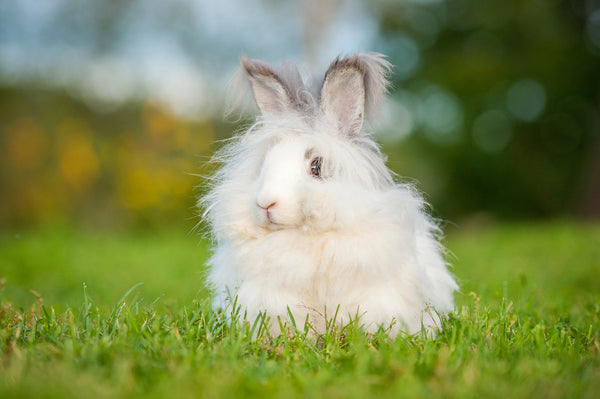Know Your Fiber: Angora
Posted on October 01 2017

Angora bunnies! Just the words evoke visions of fluffy, cuddly rabbits. Or for fiber artists, visions of soft and amazingly cozy sweaters, hats, scarves, and gloves.
How humans discovered and bred the first long-haired rabbits for their fiber is not certain. The first recorded instance of raising penned rabbits was by the Romans around 100 BCE. These first penned rabbits, who were not quite yet domesticated, were brought back to Rome from their military campaigns in what is today known as Spain. It is a matter of some debate as to whether or not rabbits brought from Rome to Turkey provided the stock from which Angora rabbits were eventually bred. However, it is generally agreed that all Angora rabbits today are likely descended from long-haired rabbits that were originally bred around Ankara, Turkey. From there the raising of these rabbits began to spread throughout Eastern Europe by around 500-600 CE. There are some records of tribes living in the Carpathian Mountains who raised these rabbits for their warm fiber.
Western Europe appears to not have become aware of Angora rabbits until the 1500s, when Angora rabbits made their way to England, somehow skipping the rest of Western Europe on the way there. Renamed English Silk Hares, fiber from these rabbits began to become very popular among those in Europe with the finances to afford it. It was such a profitable industry that the English government made it a crime to export the rabbits.
As time passed, restrictions were loosened, or just plain ignored. The first Angoras arrived on English ships to France in 1723. Perhaps to avoid legal repercussions, or perhaps it was the honest truth, the English sailors said that they had brought the rabbits from their original homeland in Turkey, naming the rabbits “Angola” – an Anglicized pronunciation of the city of Ankara – which eventually became pronounced “Angora.” Sold for high prices, Angora rabbits became popular as pets for the upper classes. Marie Antoinette kept pet Angora rabbits that, unfortunately, met the same fate as the Queen: executed during the French Revolution.
Even though Angora rabbits became popular pets, it wasn’t long before breeding Angoras for fiber production began in earnest throughout Western Europe. By 1777, Angoras had also made their way to Germany, where prizes for the best angora fiber were offered by the Prussian government during 1780-1781. However, despite attempts from England, Germany and other Western European countries, France soon dominated the world Angora fiber market, and would do so all the way until 1965.
Rabbits intended to start an American Angora fiber production industry were being imported to the United States by the 1920s. However, with the advent of synthetic fibers over the next several decades, the production of Angora fiber remained a mostly cottage industry in the United States. However, even as synthetic fibers became more popular, angora remained a treasured luxury fiber that was a mainstay of the fashion industry up through the mid-1900s. For some, like well-known director Ed Wood of low-budget science-fiction and horror movie fame, interest in the fiber bordered on obsession. Ed Wood admitted to an intense fascination with Angora – he would sometimes go out of his way to include Angora sweaters in his films, and even used Ann Gora as one of his pen names.
Today, most angora production in the United State is from small cottage industries, with 95% of angora being imported from China. Small yarn mills and fiber shops, like Northwest Yarns, are typically buyers of American Angora fiber, with much of the imported fiber going to the mass-produced fashion industry.
There are quite a number of breeds of Angora, but the most well-known for their fiber are the English, French, Satin, and Giant. Typically, the fiber is plucked from the rabbit while it is molting (about every four months), although they may also be sheared. However, shearing can result in a lower quality of fiber, as more guard hairs are included in the resulting fiber. While some Angora production outside of the United States has been criticized for its poor treatment of rabbits, we can assure you that the Angora we stock for spinning has been hand-plucked from happy and well-loved bunnies. Our supplier is a close friend of the shop!
Angora is a very warm fiber with a hollow core that contributes to its superior insulating properties. The fiber itself is also very fine (10-18 microns) and produces the classic fuzzy Angora “halo” when spun into yarn. It is frequently combined with wool or other fibers to increase elasticity and to make it easier to spin.
Don’t miss out on working with this historic and classic luxury fiber! We have Angora-blend yarns for sale, as well as washed, hand-plucked Angora ready to be spun. Stop on by to check out all the Angora products we have to offer!
How humans discovered and bred the first long-haired rabbits for their fiber is not certain. The first recorded instance of raising penned rabbits was by the Romans around 100 BCE. These first penned rabbits, who were not quite yet domesticated, were brought back to Rome from their military campaigns in what is today known as Spain. It is a matter of some debate as to whether or not rabbits brought from Rome to Turkey provided the stock from which Angora rabbits were eventually bred. However, it is generally agreed that all Angora rabbits today are likely descended from long-haired rabbits that were originally bred around Ankara, Turkey. From there the raising of these rabbits began to spread throughout Eastern Europe by around 500-600 CE. There are some records of tribes living in the Carpathian Mountains who raised these rabbits for their warm fiber.
Western Europe appears to not have become aware of Angora rabbits until the 1500s, when Angora rabbits made their way to England, somehow skipping the rest of Western Europe on the way there. Renamed English Silk Hares, fiber from these rabbits began to become very popular among those in Europe with the finances to afford it. It was such a profitable industry that the English government made it a crime to export the rabbits.
As time passed, restrictions were loosened, or just plain ignored. The first Angoras arrived on English ships to France in 1723. Perhaps to avoid legal repercussions, or perhaps it was the honest truth, the English sailors said that they had brought the rabbits from their original homeland in Turkey, naming the rabbits “Angola” – an Anglicized pronunciation of the city of Ankara – which eventually became pronounced “Angora.” Sold for high prices, Angora rabbits became popular as pets for the upper classes. Marie Antoinette kept pet Angora rabbits that, unfortunately, met the same fate as the Queen: executed during the French Revolution.
Even though Angora rabbits became popular pets, it wasn’t long before breeding Angoras for fiber production began in earnest throughout Western Europe. By 1777, Angoras had also made their way to Germany, where prizes for the best angora fiber were offered by the Prussian government during 1780-1781. However, despite attempts from England, Germany and other Western European countries, France soon dominated the world Angora fiber market, and would do so all the way until 1965.
Rabbits intended to start an American Angora fiber production industry were being imported to the United States by the 1920s. However, with the advent of synthetic fibers over the next several decades, the production of Angora fiber remained a mostly cottage industry in the United States. However, even as synthetic fibers became more popular, angora remained a treasured luxury fiber that was a mainstay of the fashion industry up through the mid-1900s. For some, like well-known director Ed Wood of low-budget science-fiction and horror movie fame, interest in the fiber bordered on obsession. Ed Wood admitted to an intense fascination with Angora – he would sometimes go out of his way to include Angora sweaters in his films, and even used Ann Gora as one of his pen names.
Today, most angora production in the United State is from small cottage industries, with 95% of angora being imported from China. Small yarn mills and fiber shops, like Northwest Yarns, are typically buyers of American Angora fiber, with much of the imported fiber going to the mass-produced fashion industry.
There are quite a number of breeds of Angora, but the most well-known for their fiber are the English, French, Satin, and Giant. Typically, the fiber is plucked from the rabbit while it is molting (about every four months), although they may also be sheared. However, shearing can result in a lower quality of fiber, as more guard hairs are included in the resulting fiber. While some Angora production outside of the United States has been criticized for its poor treatment of rabbits, we can assure you that the Angora we stock for spinning has been hand-plucked from happy and well-loved bunnies. Our supplier is a close friend of the shop!
Angora is a very warm fiber with a hollow core that contributes to its superior insulating properties. The fiber itself is also very fine (10-18 microns) and produces the classic fuzzy Angora “halo” when spun into yarn. It is frequently combined with wool or other fibers to increase elasticity and to make it easier to spin.
Don’t miss out on working with this historic and classic luxury fiber! We have Angora-blend yarns for sale, as well as washed, hand-plucked Angora ready to be spun. Stop on by to check out all the Angora products we have to offer!

Follow US